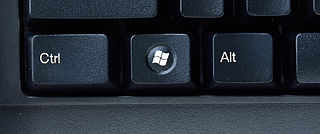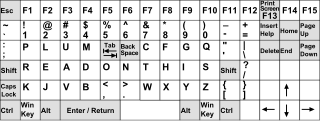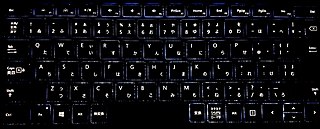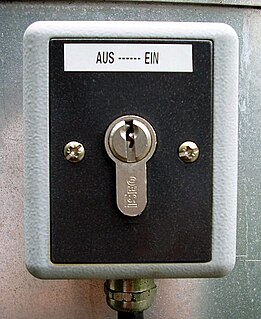
QWERTY is a keyboard design for Latin-script alphabets. The name comes from the order of the first six keys on the top left letter row of the keyboard. The QWERTY design is based on a layout created for the Sholes and Glidden typewriter and sold to E. Remington and Sons in 1873. It became popular with the success of the Remington No. 2 of 1878, and remains in widespread use.

An electronic keyboard or digital keyboard is an electronic musical instrument, an electronic or digital derivative of keyboard instruments.
Broadly speaking, the term electronic keyboard or just a keyboard can refer to any type of digital or electronic keyboard instrument. These include synthesizers, digital pianos, stage pianos, electronic organs and digital audio workstations. However, an electronic keyboard is more specifically a synthesizer with a built-in low-wattage power amplifier and small loudspeakers.

The QWERTZ or QWERTZU keyboard is a typewriter and keyboard layout widely used in Central Europe. The name comes from the first six letters at the top left of the keyboard:.

AZERTY is a specific layout for the characters of the Latin alphabet on typewriter keys and computer keyboards. The layout takes its name from the first six letters to appear on the first row of alphabetical keys; that is,. Similar to the German QWERTZ layout, it is modelled on the English QWERTY layout. It is used by most French speakers based in Europe, although France and Belgium each have their own national variations on the layout. Luxembourg and Switzerland use the Swiss QWERTZ keyboard. Most of the residents of Quebec, the mainly French-speaking province of Canada, use a QWERTY keyboard that has been adapted to the French language such as the Multilingual Standard keyboard CAN/CSA Z243.200-92 which is stipulated by the government of Quebec and the Government of Canada.

The Windows logo key is a keyboard key which was originally introduced on the Microsoft Natural keyboard in 1994. This key became a standard key on PC keyboards. In Windows tapping the key brings up the start menu. Ctrl+Esc performs the same function, in case the keyboard lacks this key.

A membrane keyboard is a computer keyboard whose "keys" are not separate, moving parts, as with the majority of other keyboards, but rather are pressure pads that have only outlines and symbols printed on a flat, flexible surface. Very little, if any, tactile feedback is felt when using such a keyboard, and error-free blind typing is difficult.

The shift key is a modifier key on a keyboard, used to type capital letters and other alternate "upper" characters. There are typically two shift keys, on the left and right sides of the row below the home row. The shift key's name originated from the typewriter, where one had to press and hold the button to shift up the case stamp to change to capital letters;
the shift key was first used in the Remington No. 2 Type-Writer of 1878; the No. 1 model was capital-only.

Caps Lock is a button on a computer keyboard that causes all letters of Latin-based scripts to be generated in capital letters. It is a toggle key: each press reverses its action. Some keyboards also implement a light, so as to give visual feedback about whether it is on or off. Exactly what Caps Lock does depends on the keyboard hardware, the operating system, the device driver, and the keyboard layout. Usually, the effect is limited to letter keys; letters of Latin-based scripts are capitalised, while letters of other scripts and non-letter characters are generated normally.

The Alt key on a computer keyboard is used to change (alternate) the function of other pressed keys. Thus, the Alt key is a modifier key, used in a similar fashion to the Shift key. For example, simply pressing "A" will type the letter a, but if you hold down either Alt key while pressing A, the computer will perform an Alt+A function, which varies from program to program. The international standard ISO/IEC 9995-2 calls it Alternate key. The key is located on either side of the Space bar, but in non-US PC keyboard layouts, rather than a second Alt key, there is an 'Alt Gr' key to the right of the space bar. Both placements are in accordance with ISO/IEC 9995-2.

The Option key is a modifier key (ALT) present on Apple keyboards. It is located between the Control key and Command key on a typical Mac keyboard. There are two option keys on modern Mac desktop and notebook keyboards, one on each side of the space bar.

The PLUM keyboard is a computer keyboard which varies from the traditional QWERTY keyboard in both physical key layout and letter arrangement. Unlike most keyboards, the PLUM keyboard organizes keys in a square grid, as opposed to the staggered rows of a typewriter. Though the Plum Keyboard is currently off-line, it is still being promoted.

The Insert key is a key commonly found on computer keyboards.

Japanese input methods are the methods used to input Japanese characters on a computer.

A virtual keyboard is a software component that allows the input of characters without the need for physical keys. The interaction with the virtual keyboard happens mostly via a touchscreen interface, but can also take place in a different form in virtual or augmented reality.
Rollover is the ability of a computer keyboard to correctly handle several simultaneous keystrokes.

A Hebrew keyboard comes in two different keyboard layouts. Most Hebrew keyboards are bilingual, as Latin characters are necessary for URLs and Email addresses. Trilingual keyboard options also exist, with the third script being Arabic or Russian, due to the sizable Arabic- and Russian-speaking populations in Israel.

In computing, a computer keyboard is a typewriter-style device which uses an arrangement of buttons or keys to act as mechanical levers or electronic switches. Following the decline of punch cards and paper tape, interaction via teleprinter-style keyboards became the main input method for computers.

The Dvorak Simplified Keyboard ( d -VOR-ak) is a keyboard layout patented during 1936 by August Dvorak and his brother-in-law, William Dealey. Several modifications have since been designed by the team directed by Dvorak or by ANSI. These variations have been collectively or individually termed the Simplified Keyboard or American Simplified Keyboard, but they all have come to be known commonly as the Dvorak keyboard or Dvorak layout;
A keyboard layout is any specific mechanical, visual, or functional arrangement of the keys, legends, or key-meaning associations (respectively) of a computer, typewriter, or other typographic keyboard.
Mechanical layout is the placements and keys of a keyboard. Visual layout is the arrangement of the legends that appear on the keys of a keyboard. Functional layout is the arrangement of the key-meaning associations, determined in software, of all the keys of a keyboard.
















